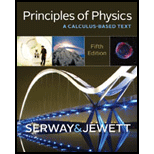
Concept explainers
(a)
The depth of the well
(a)
Answer to Problem 55P
The well has a depth of
Explanation of Solution
The well can be considered as a pipe open at one end and closed at the other end. The fundamental modes of vibration of the pipe now show odd harmonics. Assume the depth of the well to be
Write the equation for the depth of the well given that the vibrations are odd harmonics.
Here,
Write the equation for the wavelength in the
Here,
Substitute equation (II) in equation (I).
Write the equation for the depth of the well for the next resonance in succession to the previous.
Here,
Write the equation for the wavelength in the
Here,
Substitute equation (V) in equation (IV).
Conclusion:
Substitute
Substitute
Compare equation (VI) and equation (VII) as they represent two successive resonances.
Substitute
Therefore, the depth of the well is
(b)
The number of antinodes
(b)
Answer to Problem 55P
There are seven antinodes in the standing wave.
Explanation of Solution
The well is open at one end and closed at the other end thereby showing odd harmonics. Write the equation for the frequency of the first harmonic of the well.
Here,
Substitute
Conclusion:
The pattern of the first harmonic is
The ratio of the frequency of the standing wave to the frequency of the first harmonic tells to which harmonic the frequency of the standing waves belongs.
Therefore, the frequency of the standing wave belongs to
Therefore, there are
Want to see more full solutions like this?
Chapter 14 Solutions
Principles of Physics: A Calculus-Based Text
- Mick and Rick are twins born on Earth in the year 2175. Rick grows up to be an Earth-bound robotics technician while Mick becomes an intergalactic astronaut. Mick leaves the Earth on his first space mission in the year 2200 and travels, according to his clock, for 10 years at a speed of 0.75c. Unfortunately, at this point in his journey, the structure of his ship undergoes mechanical breakdown and the ship explodes. How old is Rick when his brother dies?arrow_forwardHi, I have canceled, why did you charge me again?arrow_forwardNo chatgpt pls will upvotearrow_forward
 Physics for Scientists and Engineers: Foundations...PhysicsISBN:9781133939146Author:Katz, Debora M.Publisher:Cengage Learning
Physics for Scientists and Engineers: Foundations...PhysicsISBN:9781133939146Author:Katz, Debora M.Publisher:Cengage Learning Principles of Physics: A Calculus-Based TextPhysicsISBN:9781133104261Author:Raymond A. Serway, John W. JewettPublisher:Cengage Learning
Principles of Physics: A Calculus-Based TextPhysicsISBN:9781133104261Author:Raymond A. Serway, John W. JewettPublisher:Cengage Learning University Physics Volume 1PhysicsISBN:9781938168277Author:William Moebs, Samuel J. Ling, Jeff SannyPublisher:OpenStax - Rice University
University Physics Volume 1PhysicsISBN:9781938168277Author:William Moebs, Samuel J. Ling, Jeff SannyPublisher:OpenStax - Rice University Physics for Scientists and Engineers, Technology ...PhysicsISBN:9781305116399Author:Raymond A. Serway, John W. JewettPublisher:Cengage Learning
Physics for Scientists and Engineers, Technology ...PhysicsISBN:9781305116399Author:Raymond A. Serway, John W. JewettPublisher:Cengage Learning College PhysicsPhysicsISBN:9781305952300Author:Raymond A. Serway, Chris VuillePublisher:Cengage Learning
College PhysicsPhysicsISBN:9781305952300Author:Raymond A. Serway, Chris VuillePublisher:Cengage Learning College PhysicsPhysicsISBN:9781285737027Author:Raymond A. Serway, Chris VuillePublisher:Cengage Learning
College PhysicsPhysicsISBN:9781285737027Author:Raymond A. Serway, Chris VuillePublisher:Cengage Learning





